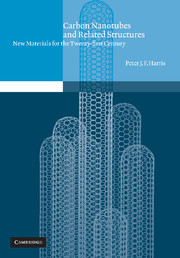Book contents
- Frontmatter
- Contents
- Acknowledgements
- 1 Introduction
- 2 Synthesis: Preparation methods, growth mechanisms and processing techniques
- 3 Structure
- 4 The physics of nanotubes
- 5 Nanocapsules and nanotest-tubes
- 6 The ultimate carbon fibre? The mechanical properties of carbon nanotubes
- 7 Curved crystals, inorganic fullerenes and nanorods
- 8 Carbon onions and spheroidal carbon
- 9 Future directions
- Name index
- Subject index
7 - Curved crystals, inorganic fullerenes and nanorods
Published online by Cambridge University Press: 28 January 2010
- Frontmatter
- Contents
- Acknowledgements
- 1 Introduction
- 2 Synthesis: Preparation methods, growth mechanisms and processing techniques
- 3 Structure
- 4 The physics of nanotubes
- 5 Nanocapsules and nanotest-tubes
- 6 The ultimate carbon fibre? The mechanical properties of carbon nanotubes
- 7 Curved crystals, inorganic fullerenes and nanorods
- 8 Carbon onions and spheroidal carbon
- 9 Future directions
- Name index
- Subject index
Summary
Daedalus, who published detailed predictions of hollow graphite
molecules years ago, points out that other substances with sheet
molecules, such as molybdenum disulphide and mica, should also
fragment into flakes and curl up under the same treatment.
David Jones, New Scientist, 24 April 1986Following the discovery of C60 in 1985, the ever-inventive Daedalus sought to maintain his lead over the experimentalists by putting forward the idea of inorganic fullerenes. A number of inorganic compounds form graphite-like layered crystals, so the idea of closed structures based on these materials certainly seemed plausible. In fact curved inorganic crystals had been known since the 1950s, having been proposed theoretically by Linus Pauling in 1930 (7.1). The most striking example occurs in the chrysotile form of serpentine, the primary constituent of most asbestos, which occurs primarily as tightly curled tubular structures. However, such structures differ from fullerenes in that the curvature derives solely from a structural mismatch between adjacent layers. In a true inorganic fullerene the curvature would be associated with point defects equivalent to the pentagons in carbon fullerenes. Particles of tungsten disulphide and other dichalcogenides with just this kind of structure have now been synthesised (7.2). Yet again the discovery was serendipitous, and occurred as a byproduct of attempts by Reshef Tenne and co-workers at the Weizmann Institute in Israel to prepare thin films of tungsten disulphide for use in solar cells. Subsequent work has shown that the inorganic fullerenes have exceptional lubricating properties.
Boron nitride is another material which exists in a graphite-like layered form, and in the 1980s various groups showed that graphite hybrids containing C, B and N could be prepared (e.g. 7.3).
- Type
- Chapter
- Information
- Carbon Nanotubes and Related StructuresNew Materials for the Twenty-first Century, pp. 213 - 234Publisher: Cambridge University PressPrint publication year: 1999



